2014.5 Peugeot Bipper oil
[x] Cancel search: oilPage 18 of 192

16
Bipper_en_Chap01_vue-ensemble_ed02-2014
emission controls ....................34, 151
Bulbs, lighting, changing
bulbs
.......
.............................
161-165
Opening the bonnet
....................... 144
u
nder the bonnet
....................
145-146
Identification markings, serial number, paint, tyres
.......
........................... 183 Changing a wiper blade
.................
166
e
ngine technical data
.............180-181
Dimensions
............................ 174-175,
176-177. 178-179
Weights
.......................................... 182
TECHNICAL DATA - MAINTENANCE
levels .....................................147-14 8
●
dipstick,
●
power steering fluid,
●
brake fluid,
●
coolant,
●
screenw
ash.
Checks.................................... 149-151
●
battery
,
●
air/passenger compartment filter
,
●
oil filter
,
●
particle emissions filter (1.3 HDi 75),
●
parking brake,
●
brake pads.
e
ngine fuses
...................167, 170-171
Location
Page 24 of 192
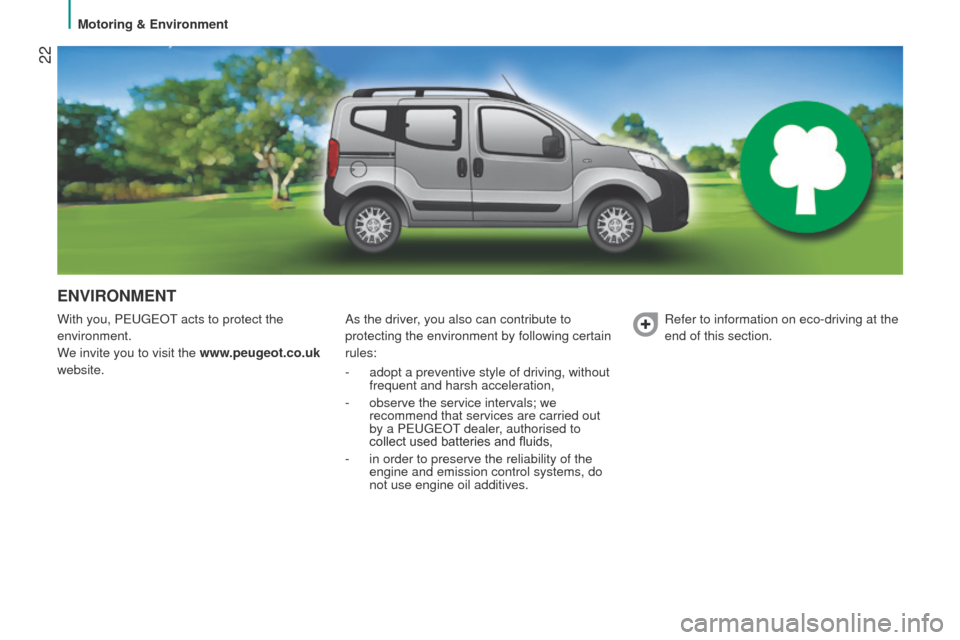
22
Bipper_en_Chap02_eco-conduite_ed02-2014
ENVIRONMENT
With you, PeugeOt acts to protect the
environment.
W
e invite you to visit the www.peugeot.co.uk
website. As the driver, you also can contribute to
protecting the environment by following certain
rules:
Refer to information on eco-driving at the
end of this section.
-
adopt a preventive style of driving, without
frequent and harsh acceleration,
-
observe the service intervals; we
recommend that services are carried out
by a P
euge O t
dealer
, authorised to
collect used batteries and fluids,
-
in order to preserve the reliability of the
engine and emission control systems, do
not use engine oil additives.
Motoring & Environment
Page 26 of 192
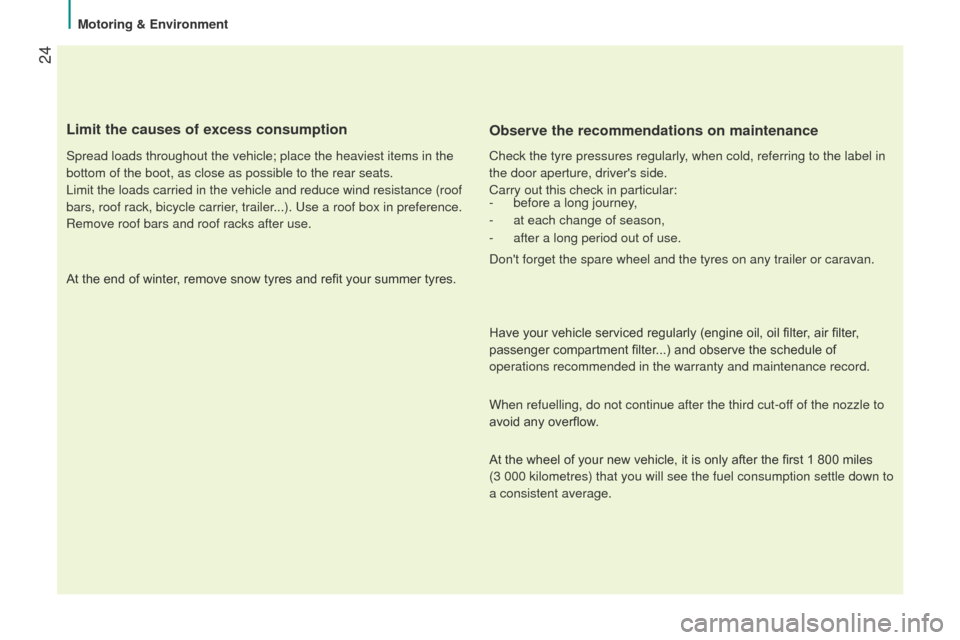
24
Bipper_en_Chap02_eco-conduite_ed02-2014
Limit the causes of excess consumption
Spread loads throughout the vehicle; place the heaviest items in the
bottom of the boot, as close as possible to the rear seats.
l
imit the loads carried in the vehicle and reduce wind resistance (roof \
bars, roof rack, bicycle carrier, trailer...).
u se a roof box in preference.
Remove roof bars and roof racks after use.
At the end of winter, remove snow tyres and refit your summer tyres.
Observe the recommendations on maintenance
Check the tyre pressures regularly, when cold, referring to the label in
the door aperture, driver's side.
Carry out this check in particular:
-
before a long journey
,
-
at each change of season,
-
after a long period out of use.
Don't forget the spare wheel and the tyres on any trailer or caravan.
Have your vehicle serviced regularly (engine oil, oil filter
, air filter,
passenger compartment filter...) and observe the schedule of
operations recommended in the warranty and maintenance record.
When refuelling, do not continue after the third cut-off of the nozzle to
avoid any overflow.
At the wheel of your new vehicle, it is only after the first 1 800 miles
(3
000 kilometres) that you will see the fuel consumption settle down to
a consistent average.
Motoring & Environment
Page 28 of 192
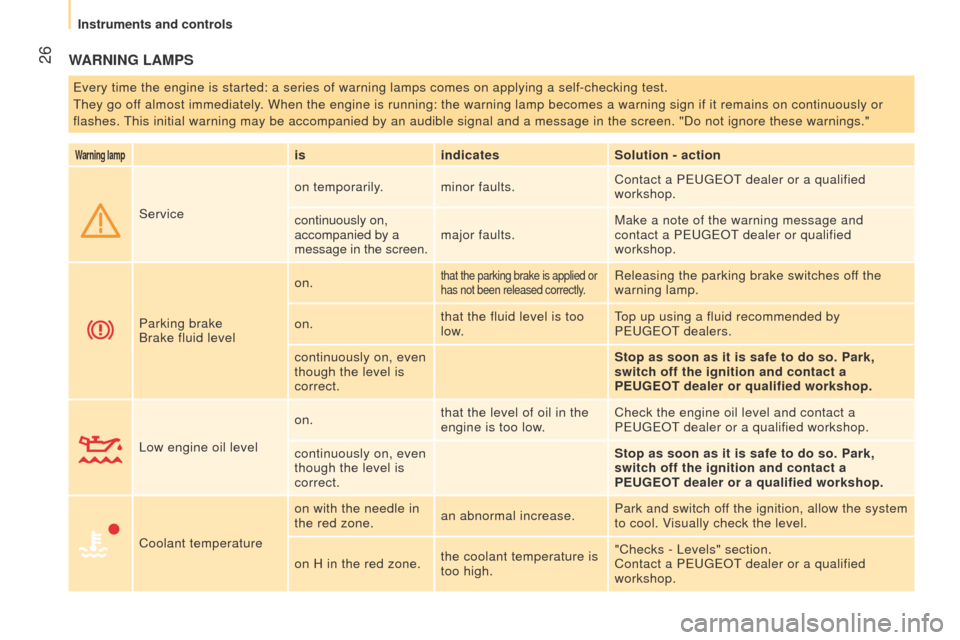
26
Bipper_en_Chap03_pret-a-partir_ed02-2014
WARNING LAMPS
every time the engine is started: a series of warning lamps comes on appl\
ying a self-checking test.
t
hey go off almost immediately. When the engine is running: the warning lamp becomes a warning sign if\
it remains on continuously or
flashes.
t
his initial warning may be accompanied by an audible signal and a messag\
e in the screen. "Do not ignore these warnings."
Warning lampis indicates Solution - action
Service on temporarily. minor faults.
Contact a P
euge O t
dealer or a qualified
workshop.
continuously on,
accompanied by a
message in the screen. major faults. Make a note of the warning message and
contact a P
euge O t
dealer or qualified
workshop.
Parking brake
Brake fluid level on.
that the parking brake is applied or
has not been released correctly.Releasing the parking brake switches off the
warning lamp.
on. that the fluid level is too
low.
top up using a fluid recommended by
P
euge O t
dealers.
continuously on, even
though the level is
correct. Stop as soon as it is safe to do so. Park,
switch off the ignition and contact a
PEUGEOT dealer or qualified workshop.
l
ow engine oil level on.
that the level of oil in the
engine is too low. Check the engine oil level and contact a
P
euge O t
dealer or a qualified workshop.
continuously on, even
though the level is
correct. Stop as soon as it is safe to do so. Park,
switch off the ignition and contact a
PEUGEOT dealer or a qualified workshop.
Coolant temperature on with the needle in
the red zone.
an abnormal increase. Park and switch off the ignition, allow the system
to cool. Visually check the level.
on H in the red zone. the coolant temperature is
too high. "Checks -
l evels" section.
Contact a P
euge O t
dealer or a qualified
workshop.
Instruments and controls
Page 29 of 192
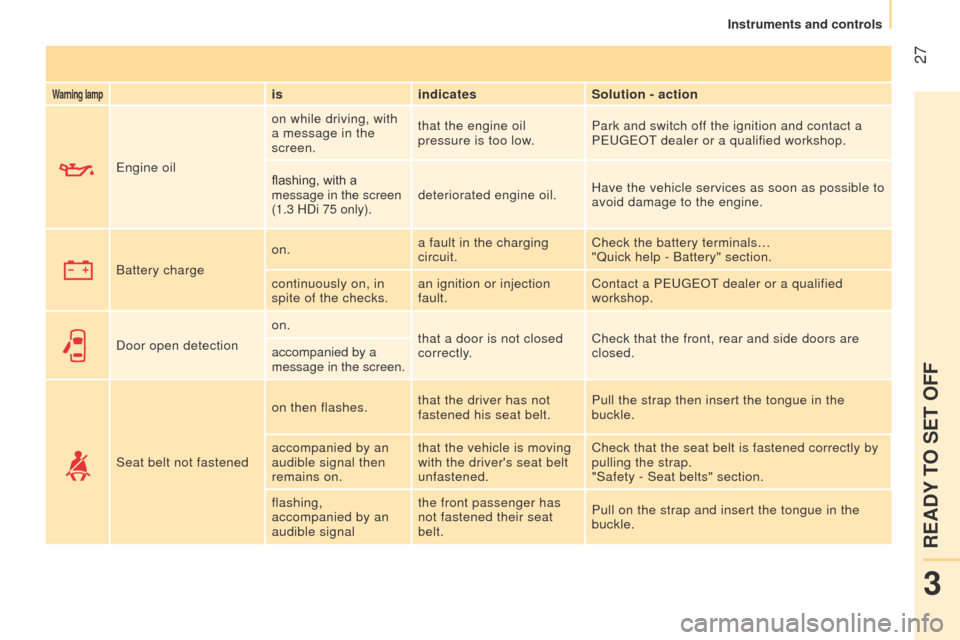
27
Bipper_en_Chap03_pret-a-partir_ed02-2014
Warning lampisindicates Solution - action
e
ngine oil on while driving, with
a message in the
screen.
that the engine oil
pressure is too low.
Park and switch off the ignition and contact a
P
euge O t
dealer or a qualified workshop.
flashing, with a
message in the screen
(1.3 HDi 75 only). deteriorated engine oil.
Have the vehicle services as soon as possible to
avoid damage to the engine.
Battery charge on.
a fault in the charging
circuit. Check the battery terminals…
"Quick help - Battery" section.
continuously on, in
spite of the checks. an ignition or injection
fault. Contact a P
euge O t
dealer or a qualified
workshop.
Door open detection on.
that a door is not closed
correctly. Check that the front, rear and side doors are
closed.
accompanied by a
message in the screen.
Seat belt not fastened on then flashes.
that the driver has not
fastened his seat belt. Pull the strap then insert the tongue in the
buckle.
accompanied by an
audible signal then
remains on. that the vehicle is moving
with the driver's seat belt
unfastened. Check that the seat belt is fastened correctly by
pulling the strap.
"Safety - Seat belts" section.
flashing,
accompanied by an
audible signal the front passenger has
not fastened their seat
belt.
Pull on the strap and insert the tongue in the
buckle.
3
READY TO SET OFF
Instruments and controls
Page 37 of 192

35
Bipper_en_Chap03_pret-a-partir_ed02-2014
SERVICE INDICATORENGINE OIL WARNING LAMP
L IGHTING DIMMER
the dimmer is active when the sidelamps
are on.
Refer to the list of checks in the
warranty and maintenance record
which was given to you on delivery of
the vehicle.
After a few seconds, the screen returns to its
usual functions.
u
se these controls to adjust the
brightness of the instrument
panel and the audio system panel
lighting.
t
he screen in the instrument panel
informs you when the next service is due,
in accordance with the Manufacturer's
servicing schedule indicated in the warranty
and maintenance record.
t
his information
is determined in relation to the distance
travelled since the previous service. Low engine oil pressure
Oil deterioration (1.3 HDi 75 hp engine only)
t
he warning lamp comes on
continuously, accompanied by a
message in the instrument panel
screen, when the system detects
that the oil pressure is too low.
t
he warning lamp flashes,
accompanied by a message in the
instrument panel screen, when the
system detects deterioration of the
engine oil.
t
he flashing of this warning lamp
should not be considered as a fault wit the
vehicle, but rather as an indication to the
driver that the normal use of the vehicle now
requires that the oil be changed.
If the oil is not changed, when a
second level of deterioration is
reached, the emissions warning
lamp comes on in the instrument
panel and the engine speed is restricted to
3000 rpm.
to avoid damaging the engine, it is
recommended that the oil be changed
on flashing of the engine oil warning lamp.
Stop as soon as it is safe to do so: park,
switch off the ignition and contact a
PEUGEOT dealer or a qualified workshop. If the oil is still not changed, when a third
level of deterioration is reached, the engine
speed is restricted to 1500 rpm, so as to
avoid any damage.
3
READY TO SET OFF
Instruments and controls
Page 89 of 192
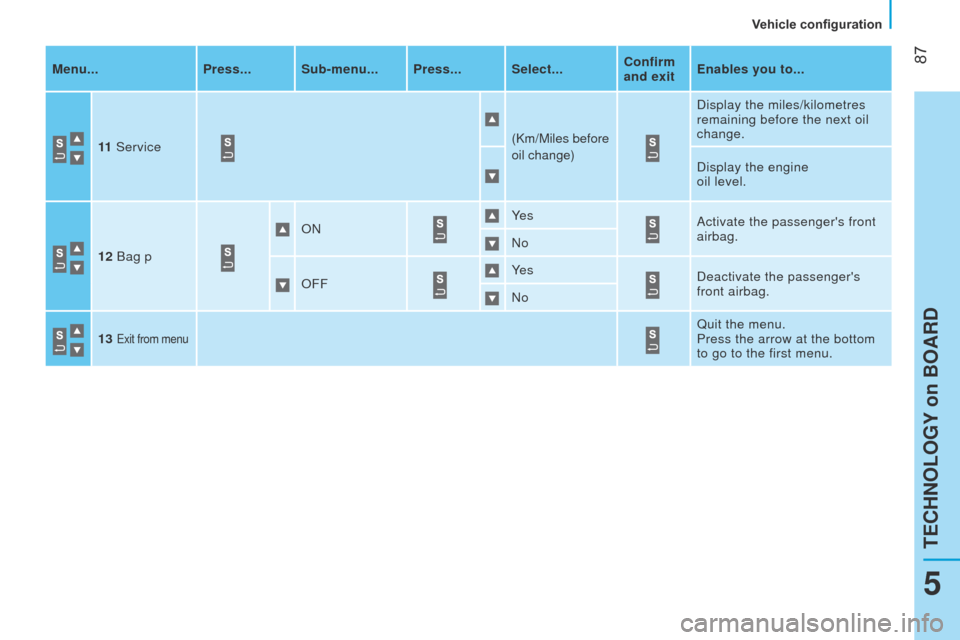
87
Bipper_en_Chap05_technologie_ed02-2014
Menu...Press... Sub-menu... Press... Select... Confirm
and exitEnables you to...
11 Service (Km/Miles before
oil change)Display the miles/kilometres
remaining before the next oil
change.
Display the engine
oil level.
12 Bag p ON
Ye s
Activate the passenger's front
airbag.
No
OFF Ye s
Deactivate the passenger's
front airbag.
No
13
exit from menuQuit the menu.
Press the arrow at the bottom
to go to the first menu.
5
TECHNOLOGY on BOARD
Vehicle configuration
Page 114 of 192
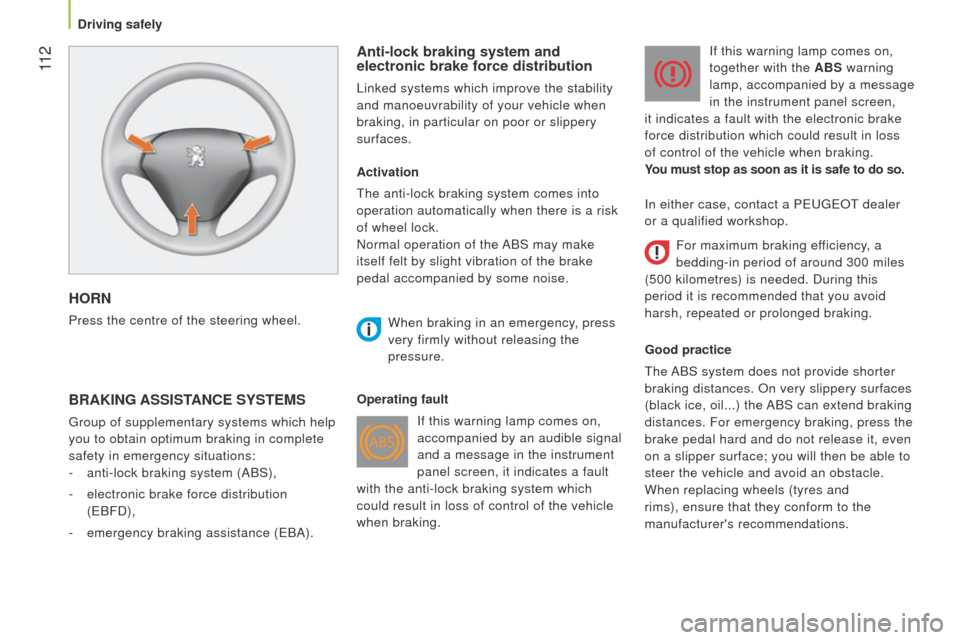
11 2
Bipper_en_Chap06_securite_ed02-2014
HORN
Press the centre of the steering wheel.
Anti-lock braking system and
electronic brake force distribution
linked systems which improve the stability
and manoeuvrability of your vehicle when
braking, in particular on poor or slippery
surfaces.
BRAKING ASSISTANCE SYSTEMS
group of supplementary systems which help
you to obtain optimum braking in complete
safety in emergency situations:
-
anti-lock braking system (ABS),
-
electronic brake force distribution
(
e BFD),
-
emergency braking assistance (
e BA).Activation
t
he anti-lock braking system comes into
operation automatically when there is a risk
of wheel lock.
Normal operation of the ABS may make
itself felt by slight vibration of the brake
pedal accompanied by some noise.
When braking in an emergency
, press
very firmly without releasing the
pressure.
Operating fault If this warning lamp comes on,
accompanied by an audible signal
and a message in the instrument
panel screen, it indicates a fault
with the anti-lock braking system which
could result in loss of control of the vehicle
when braking. If this warning lamp comes on,
together with the ABS warning
lamp, accompanied by a message
in the instrument panel screen,
it indicates a fault with the electronic brake
force distribution which could result in loss
of control of the vehicle when braking.
You must stop as soon as it is safe to do so.
Good practice
t
he ABS system does not provide shorter
braking distances. On very slippery surfaces
(black ice, oil...) the ABS can extend braking
distances. For emergency braking, press the
brake pedal hard and do not release it, even
on a slipper surface; you will then be able to
steer the vehicle and avoid an obstacle.
When replacing wheels (tyres and
rims), ensure that they conform to the
manufacturer's recommendations. In either case, contact a P euge O t
dealer
or a qualified workshop.
For maximum braking efficiency, a
bedding-in period of around 300 miles
(500 kilometres) is needed. During this
period it is recommended that you avoid
harsh, repeated or prolonged braking.
Driving safely